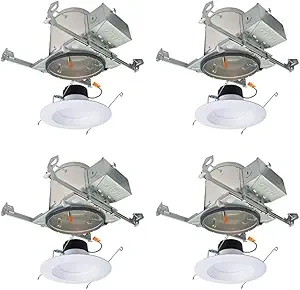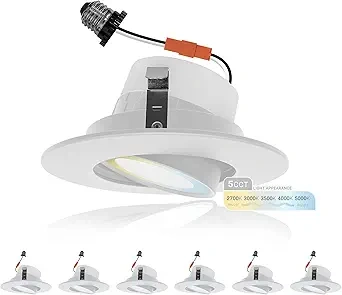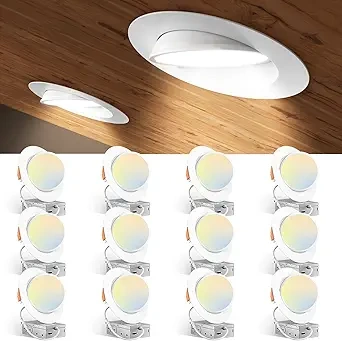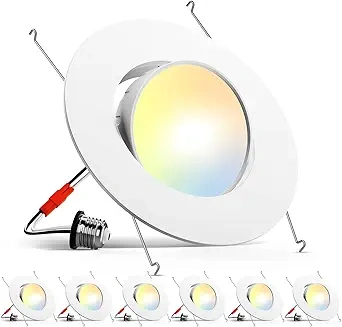Lighting a sloped or vaulted ceiling isn’t as simple as installing a few standard downlights. The unique angles and architecture of these ceilings demand precision, flexibility, and the right type of recessed fixtures to ensure balanced illumination. The best recessed lighting for sloped ceilings combines design and functionality, creating even, glare-free light that enhances your space’s depth and character.
In this guide, we’ll explore the top-rated recessed lighting solutions designed specifically for angled ceilings. You’ll discover which products perform best, how to install them properly, and what to consider before buying, so you can transform your vaulted living room, kitchen, or bedroom into a beautifully lit, modern space.
Why Traditional Recessed Lighting Fails on Slopes?
On a sloped roof, a standard fixed recessed can will follow the roof’s pitch. That means your light is aimed at an angle, often into walls, windows, or even directly into people’s eyes. You’ll get hot spots, uneven lighting, and more glare problems. Some people try to use standard downlights in a vaulted ceiling without accounting for tilt, and they wind up with weird light patterns. The better choices are angle cut adjustable recessed lighting or sloped-ceiling-specific housings, which correct for the pitch. In other words, to do this right, you can’t just treat it like flat-ceiling lighting.
Key Types: Angle Cut, Adjustable, and Sloped Housings
Angle Cut Recessed Light Fixtures
Also called sloped ceiling trims, these have a face plate that’s cut at an angle so that the lens ends up facing downward (perpendicular to the floor) even though the ceiling is angled.
Pros: Less visual “eyeball” look, cleaner aesthetic.
Cons: You must match the slope when ordering. If your roof pitch changes or your measurement is off, you may have misalignment.
Adjustable / Gimbal / Eyeball Trims
These allow “aiming” of the light after installation, you can tilt or swivel the LED inside the housing to point downward. This is essentially angle cut adjustable recessed lighting in action.
Pros: Flexible, forgiving. If you shift furniture or add wall art, you can re-angle.
Cons: The trim can look like a small spotlight (some people dislike the “eyeball” aesthetic). Also, some have limited tilt range, so extremely steep pitches may still be tricky.
Sloped Housings (Fixed with Sloped Trim)
These housings are built specifically for sloped ceilings; sometimes the housing itself is canted or offset. The trim is fixed (not adjustable) but built to match slope.
Pros: Very clean look once installed, no moving parts.
Cons: Less flexibility in aiming. If you change lighting needs or room layout, it can be limiting. Also, these are harder to source and must match your slope precisely. In practical modern installs, many pros go with adjustable trims inside standard housings and call that recessed lighting for angled ceilings.
Planning & Design Tips for Sloped Ceiling Lighting
1. Determine the Ceiling Pitch (Angle)
You need to know exactly how steep your ceiling is so you can pick trims or housings that will handle it.
2. Room Size, Spacing & Layout
Spacing rules for sloped ceilings are similar to flats: generally spacing about half the ceiling height between lights. But because the slope increases length, you might need more fixtures.
3. Avoid Glare
Always aim the beam more vertical (toward the floor) vs horizontally. The tilt adjustments or angle-cut trims help here. If you use a fixed recessed light on a slope, the result is significantly more glare.
4. Accessibility & Maintenance
Changing bulbs or repairing fixtures in a vaulted ceiling is harder. That’s why using reliable, long-life LEDs matter. With led downlights for sloped ceiling, you want durable, maintenance-minimizing designs.
5. Heat, Insulation, and Clearance
Some slopes leave little depth above the drywall. Use shallow housings or “canless” LED modules if depth is tight. Also ensure air/insulation clearance.
Top Products Worth Considering
Below are several good options you can find on Amazon or lighting specialty sellers. I’ve included pros and cons based on installation in sloped ceilings and user feedback.
1- HALO H645IC Sloped Ceiling Housing with Trim
Description:
This Halo model is purpose-built for sloped ceilings between 2/12 and 12/12 pitch. It features an IC-rated aluminum housing for direct contact with insulation, making it both energy-efficient and safe. Pair it with Halo’s H1499 adjustable trims for a clean, professional finish.
Pros:
✅ True sloped design for perfect beam direction
✅ IC-rated for insulated ceilings
✅ Easy to install with universal mounting brackets
✅ Excellent build quality and heat dissipation
Cons:
❌ Slightly expensive compared to regular housings
❌ Requires matching trims for best performance
Best For: Vaulted living rooms, cathedral dining rooms, or any ceiling above 8 feet where standard housings won’t align correctly.
2- HALO RA4-DM 4-Inch Adjustable Gimbal LED Retrofit Kit
Description:
This is one of the most popular angle cut adjustable recessed lighting kits. It’s a 4-inch retrofit with a color-selectable LED (2700K–5000K) and a tiltable gimbal head, allowing up to 35° adjustment. The matte white finish gives a modern, professional look.
Pros:
✅ Color temperature selectable (warm to daylight)
✅ Gimbal adjustment handles most slopes
✅ Dimmable and Energy Star certified
✅ Long 50,000-hour LED lifespan
Cons:
❌ May not fully align on extremely steep ceilings
❌ Slightly bulkier trim design
Best For: Homeowners who want flexible lighting without installing new housings, great for remodeling or upgrading existing recessed lights.
3- Lotus LED Lights Sloped Ceiling LED Downlight
Description:
Lotus LED makes premium sloped ceiling LED light fixtures designed for 15°–45° angled ceilings. The ultra-thin body and direct mount design eliminate the need for a can housing, perfect for tight spaces. It offers smooth dimming, glare-free optics, and true downward illumination even on steep slopes.
Pros:
✅ Ultra-thin canless design fits low clearance ceilings
✅ High lumen output with even diffusion
✅ ETL listed and IC rated
✅ No need for additional housings or trims
Cons:
❌ Higher price tag
❌ Limited color temperature options
Best For: Tight or cathedral ceilings where space is limited, and a flush finish is desired.
4-Juno 928 Series Adjustable Recessed Light for Sloped Ceilings
Description:
Juno’s 928 series offers an adjustable 6-inch trim that handles up to 45° slopes. The die-cast aluminum construction ensures durability, while the adjustable socket plate allows you to aim light exactly where you need it. It’s compatible with LED retrofit bulbs.
Pros:
✅ Great tilt range (up to 45°)
✅ Durable die-cast aluminum build
✅ Clean design blends into ceiling lines
✅ Compatible with standard housings
Cons:
❌ Requires bulb purchase separately
❌ Slightly tricky to align during installation
Best For: Larger rooms or vaulted hallways where directional flexibility matters more than ultra-slim aesthetics.
My take: For most homes, a good adjustable gimbal LED trim inside a shallow IC-rated housing gives flexibility without overpaying for custom slope housings. But for ultra-clean aesthetics or extremely steep slopes, angle-cut or sloped housings still have their place.
How to Install Recessed Lighting on a Vaulted Ceiling
- Map the layout: decide your fixture grid, factoring slope length.
- Mark positions and access holes: ideally from attic or cut temporary holes above.
- Run wiring : pulling wires over slopes often requires extra planning.
- Mount housing or joist support: for slope ceilings, use brackets or hangers that adapt to angle.
- Attach trim / gimbal / sloped trim: for angle cut adjustable recessed lighting, install the adjustable trim inside the housing.
- Aim and test: once power is on, adjust gimbals or trims to get best coverage and minimize glare.
- Seal and insulate: if ceiling is IC-rated, ensure insulation clearance; use gasketing.
- Finish : patch and paint. By the way, if you’re painting ceilings, don’t miss my article on best way to paint a ceiling.
Pros & Cons of Recessed Lighting for Sloped Ceilings
Pros
Cons
Final Thoughts
Lighting a sloped or vaulted ceiling can feel challenging, but with the right recessed fixtures, it becomes an opportunity to enhance your home’s architecture rather than fight against it. The key is choosing lighting designed to complement your ceiling’s angle, whether it’s the flexibility of the HALO RA4-DM, the sleek minimalism of Lotus LED Lights, or the professional precision of HALO H645IC housings.
Each of these lights offers a balance of beauty, functionality, and comfort, ensuring your space feels evenly illuminated without glare or dark spots. So, before you settle for standard lighting, invest in fixtures that highlight your home’s character, and make every angle shine.





Leave a Reply